S.A.YATSENKO
TAMGAS OF IRANOLINGUAL ANTIQUE AND EARLY MIDDLE AGES PEOPLES
Russian Academy of Science
Moscow Press "Eastern Literature" 2001
Chapter 6
TAMGAS AND POLITICAL HISTORY, GENEALOGY OF
SARMATO-ALAN ARISTOCRATIC CLANS
Selected Quotation
Foreword to S.A.YATSENKO work
If you see that the text calls Sarmatians "Iranians", or their word "Iranian word", do not despair. If this study was called "Türkic-lingual", it would probably never see the light of the day, and we would never have learnt that the Kangars, Sogdys, Horasmians/Horezmians, Sarmats and Alans had common clans and common clan tamgas, that the royal families of the Horezmians and Sarmatians belonged to the same clans, that the dynasties of the Bospor, Olbia, Bactria were intimately connected all the way up to the Chach by their royal bloodlines, and the details of these fascinating popular and royal carousels.
Chapter 6
TAMGAS AND POLITICAL HISTORY, GENEALOGY OF
SARMATO-ALAN ARISTOCRATIC CLANS
6.1 Research technique.
Research of regional-chronological properties of tamgas come to light the most influential aristocratic clans of Sarmato-Alans. Four basic criteria characterize them.
1. Putting tamgas on precious metals decorations.
2. Prevalence in the region (quantity, types of finds).
3. Representation in inter-regional "encyclopedias".
4. Affinity or identity with the tamgas of the royal clans and aristocracy of Horesm, Kangar (Chinese Kangüy in the Middle Seyhun/Syr-Darya), Üechji-Kushanian Bactria and Parthian-Sasanian Persia.
The 1st - mid 2nd century was a period of especially magnificent life of nomadic nobility, tamgas on gold objects - attributes of authority and the high status are eminent.
For mid 2nd - mid 3rd century, typical are small number of
golden objects in the tombs of the aristocracy, and a domination of silver products (mainly,
related to horse harness and status weapons). At that time develops a
standardization of military equipment, regarded
as an evidence of domination of the centralized organization with rigid
hierarchy, or as a new stage in the
development of the native craft manufacture and a result of the Roman
culture influence, especially after the Markoman wars.
84
Comparing the tamgas of the Sarmatian nobility and the tamgas of the Western Turkestan, the tamgas used by nobility in Sarmatia, in Horesm, Kangüy (Chach) and Bactria (Tokharistan) later appear on the royal coins. Insufficient, sketchy (in comparison with the Sarmato-Alanian) documentation about the tamgas of the Horesmian aristocracy creates this impression. Sarmatologs noted regular migrations to Sarmatia of the new Central Asian nomads every one to one and a half centuries. It should also be remembered that this or that clan of the "Siyavush descendants" could be coming to power much later then the time when was formed its tamga (by the way, some kings used the same clan tamga).
In addition, the tamgas which in Sarmatia belonged to the noble persons, frequently in Horesm they were obviously used by "ordinary" clans and families (who were participating in the manufacture of the construction saman for a labor duty, etc.). In these cases, probably, was use a common fund of tamgas.
Below are examined the tamgas of the noblest Sarmato-Alan clans in the chronological periods.
6.2. Most active noble clans of Sarmatia.
For period of the 1st century BC - mid 1st AD is typical a small number of definable tamgas and a relative modesty of the objects marked with them. West from the Dnepr, alongside with clans of the kings Farzoi and Inismei (GR. Inismeus) in the mid of the 1st - beg. of the 3rd century AD a special prominence had a clan with tamga fig. 5/84 and 6/106.
Fig. 5/84 and 6/106
![]()
![]()
It is represented on rare in the Sarmatia gravestones of the 1st-2nd centuries AD (Zaporojye, Kozyrka), on stone stelas of the 2nd-3rd centuries AD from Tetskan and Krivoi Rog, on a mirror from Olbia, and was found on one of the "encyclopedias" on the main gate of Tanais. Similar tamgas of the related clans (with one small additional line) are documented on the boundary of the 1st-2nd centuries AD in the richest burials of the Lower Don (Kobyakovo, kurgan 10), and appear at the end of the 3rd century AD among the "new nobility" of the barbarized Panticapaeum.
The clan with tamga, represented on fig. 5/83 was not less influential. In the 1st - 2nd centuries AD it is known on a gold bracelet and a tiny flagon from Olbia, on a stele from Zazdrosti, and a silver dish with this tamga reached far in the east to the upper course of Don.
Fig. 5/83
![]()
The third influential aristocratic clan in region west from the Dniepr left its tamgas (fig. 5/82) on princely Sarmatian swords decorated with gold from the 2-nd half of the 1st century AD from a tomb 1 in the (Dniepr - Translator's Note) Cataracts and from a Thracian tomb 2 in Roshava-Dragan (Bulgaria), on a potter's bowl from Bashtechek.
Fig. 5/82
![]()
85
Of the early Alanian clans of the Lower Don of mid 1st-beg. 2nd century AD especially prominent was the clan with tamga (fig. 5/41), which is known on gold sewed badges of the woman's wear (New, kurgan 12/3, Ternovka, kurgan 8/1) (Not published, V.P.Shilov's excavation of 1965), in the main "encyclopedias" from the Greek cities (marble lion No 2 from Olbia; a stone plate from Kerch/Panticapaeum with 479 tamgas; plates from Òànais) and on a stela from Beük-Degne in Azerbaijan with Sarmatian tamgas (Greek text of the inscription with tamga is dated 2nd century AD).
Fig. 5/41
![]()
In the Northern Caucasus, in the space between the Itil eastuary, Don eastuary, and Middle Kuban, i.e. in the territory which the Alanian union presumably occupied (Alania of Lucian), a tamga is met in the ransacked rich tombs of the mid 1st - mid 2nd century AD tamgas type fig. 14, i. Itmay be suggested to be a tamga of the Alanian royal clan, Aravelian's (Moses Khoren. Hist. of Armen. 2.58). Two similar tamgas, placed perpendicularly, formed a new tamga in Scythian Naples (fig. 5/25).
| Fig. 14-i | Fig. 5/25 |
|
|
|
In the Crimea steppe the only rich Sarmatian burial in Nogaychin (2nd half of the 1st century AD) contained a gold piksida with tamgas fig. 5/14, which is repeated on a stela 6 in the necropolis Zavetnoe and in the "encyclopedias" of Ukraine (plate from Kerch, Krivoi Rog).
Fig. 5/14
![]()
Only 7 tamgas have a most widespread distribution in the "encyclopedias" in Sarmatia (appearing in 4 and more points of finds).
Type 1 - tamga of the king Inensimei (Gr. Inenphimeios) Bosporian (234-239) (fig. 6/34) - 6 complexes.
Fig. 6/34
![]()
4 more types belong to the upper nobility (see above - fig. 5/41; 6/106: 4-5 complexes), fig. 5/62 (a golden bottle from a tomb 1913 in Olbia, and a kazan from Pavlovka) - 6 complexes; fig. 5/81 (a ritual marble vessel from Falcon's Tomb) - 6 complexes. The type (fig. 4/15), known on kazans of the Lower Don since a boundary AD is widely represented. The most widespread type (fig. 5/16: 7 complexes), probably, belonged to a Sarmatian clan from Scythian Naples, as it is repeatedly found in that location. The distribution of these tamgas in complexes with sacral functions over a large territory, these clans in the mid 1st - mid 3rd century AD were the most politically and economically active in Sarmatia.
| Fig. 5/41 | Fig. 6/106 | Fig. 5/62 | Fig. 5/81 | Fig. 4/15 | Fig. 5/16 |
|
|
|
|
|
|
|
86
The versatile activity of aristocratic clans is seen in a degree of representation of their tamgas in the "encyclopedias" of various territories (fig. 19). It is easy to notice, that most active participants of the reflected actions there, during various periods, were the clans of the Lower Don. In turn, the most "productive" in this sense was the short period of the highest rise of the Sarmatian world in mid 1st-mid 2nd c., when the clans of other regions are also represented widely enough in the "encyclopedias".
Fig. 19. Tamgas of the most politically active noble clans of Sarmato-AIans
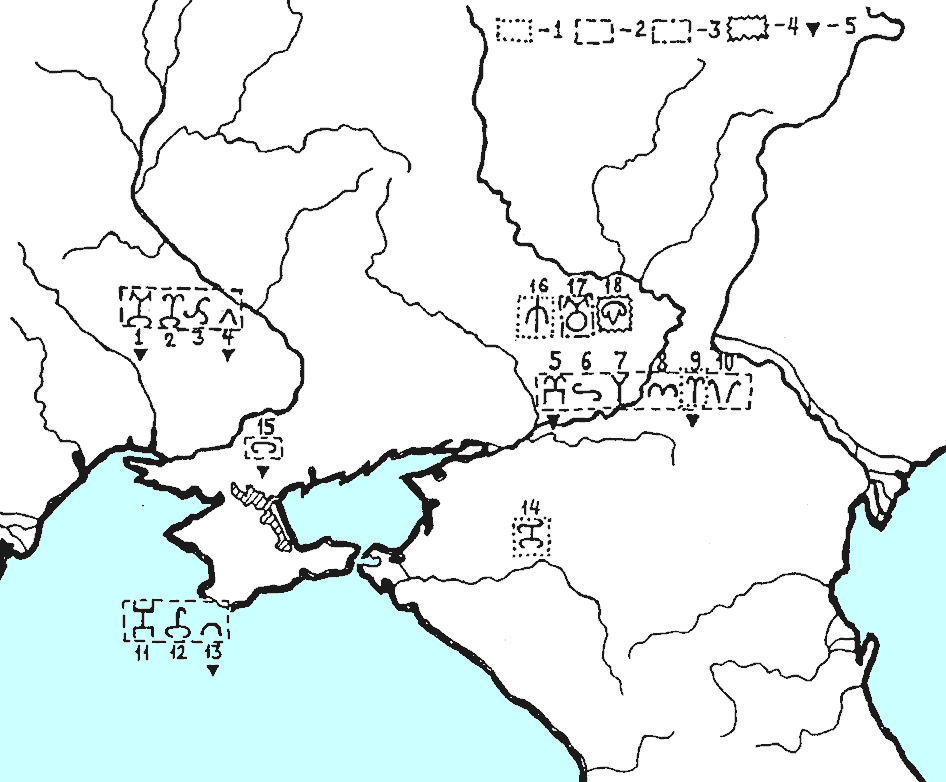
6.3. Sarmatian and Horesmian Clans.
Horesm is authentically the most ancient of the Western Turkestan independent states, usually identified with the first country of Zoroausrian faith (Arianam Vaidja), surrounded by the nomad tribes (and in tightest economic relations with them), and also in the immediate vicinity of such mighty states as Ahaemenid or Sassanid Persia, Greko-Bactria, and Kushan kingdom. Already in the days of the Alexander the Great campaign to Central Asia Horesmian king Farasman ostensibly controlledextensive territories in the west down to the Northern Black Sea Coast and Colchis (Arrian. 4.15.4). Later, in the 2nd-3rd centuries AD, the Horesmian ceramics spread in Sarmatia up to Itil river. The orientation of the eastern groups of Sarmato-Alans toward the cultured, economically advanced (but usually not too politically powerful) Horesm is quite natural. It is possible to think, that also took place mixed marriages (its enough to recollect the 2nd-3rd centuries S.Ural Temyasovo burials of women with several dress elements of far-away Fergana). By the records of Biruni and Masudi, large groups of Alans and Ases (al-Lariysa) still lived on the border of Horesm by the 8th century AD (Biruni Kharazmi, 973-1048, Geodesy. Introduction, 47).
For early Sarmatian tamgas of the 1st century BC - 1st half of the 1st century AD, the Central Asian analogies concentrate precisely in the Horesm during its 2nd period of its tamgas (fig. 28), though also exist analogies with earlier tamgas (fig. 4/22; 27/18).
Fig. 28. Tamgas of the Cheyhun/Amu-Darya and Seyhun/Syr-Darya Basins (1st cc. BC - 3rd cc. AD)
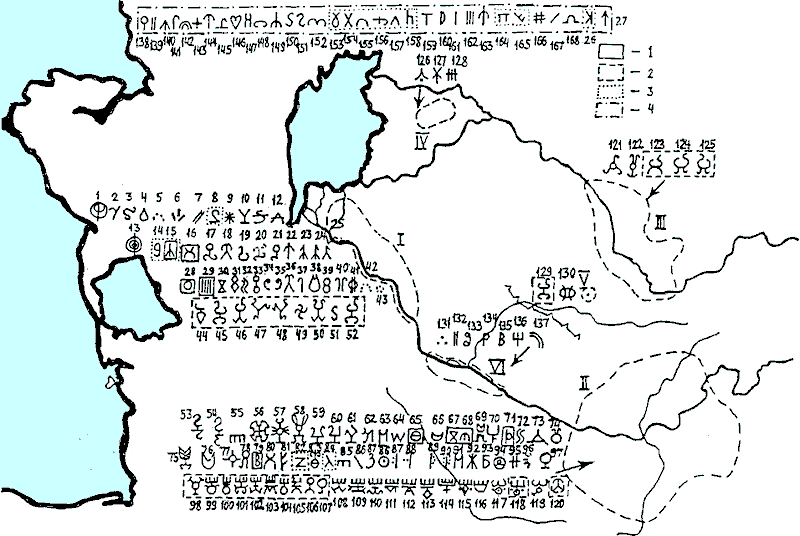
| Fig. 4/22 | Fig. 27/18 |
|
|
|
The examples identical with the Horesmian are noted first of all on the nomadic bronze family kazans of the lower Don (fig. 4/6, 8, 15) and Kuban (fig. 4/1), and also on the silver utensils from Jutovo (fig. 4/9, 12, 14).
Tamgas on the family bronze kazans and silver utensils
| Fig. 4/1 | Fig. 4/6 | Fig. 4/8 | Fig. 4/9 | Fig. 4/12 | Fig. 4/14 | Fig. 4/15 |
|
|
|
|
|
|
|
|
One Don and one Kuban tamgas from rich tombs, and one depicted on the Tanais slab (fig. 4/1, 9; 23/b, 4) are identical with the tamgas of the Horesmian kings on the coins (fig. 28/46, 50; 29/87) and, probably, really reflect contacts of noble clans. Some from these types are known not only in Horesm, but also in Bactria (fig. 28/141, 163).
| N. Pontic | Horesmian coins | Bactria | |||||
| Fig. 4/1 | Fig. 4/9 | Fig. 23/b | Fig. 28/46 | Fig. 28/50 | Fig. 29/87 | Fig. 28/141 | Fig. 28/163 |
|
|
|
|
|
|
|
|
|
87
Many exact analogues to the earlier Horesmian tamgas of the 1-st period (6th-2nd centuries BC) are among the Sarmatian tamgas of the mid 1st-mid 2nd century AD. Quite "many" of them are in the Lower Don (fig. 5/37à, 44, 47; compare: fig. 27/25, 82 and widespread 147 , used synchronously and in the neighboring territories, in this case in Sogdiana and in the lower reaches of Syr-Darya) and the neighboring Northern Azov (fig. 5/60, 62, 65; compare: fig. 27/51 and No. 148, 158, common for a number of territories). They also are known in the Crimea (fig. 5/15-16, 20; compare: fig. 27/34, 63, 111) and in the Kuban (fig. 5/50, 59; compare: fig. 27/3 and widespread no. 143), and also on the Upper Don (fig. 5/126; compare: fig. 27/14) and the (fig. 5/81, 100; compare: fig. 27/96 and widespread 148) (i.e the territories, which Sarmatians occupied a little later).
| Crimea | Lower Don | Northern Azov | Kuban | Upper Don | |||||||||
| Fig. 5/15 | Fig. 5/16 | Fig. 5/20 | Fig. 5/37à | Fig. 5/44 | Fig. 5/47 | Fig. 5/60 | Fig. 5/62 | Fig. 5/65 | Fig. 5/50 | Fig. 5/59 | Fig. 5/126 | Fig. 5/81 | Fig. 5/100 |
|
|
|
|
|
|
|
|
|
|
|
|
|
|
|
| Horesmian coins | |||||||||||||
| Fig. 27/34 | Fig. 27/63 | Fig. 27/111 | Fig. 27/82 | Fig. 27/25 | Fig. 27/147 | Fig. 27/158 | Fig. 27/148 | Fig. 27/51 | Fig. 27/3 | Fig. 27/143 | Fig. 27/14 | Fig. 27/148 | Fig. 27/96 |
|
|
|
|
|
|
|
|
|
|
|
|
|
|
|
In respect to the Sarmatian tamgas of the mid 1st - mid 2nd century AD (fig. 28), they are exact analogues with the approximately synchronous Horesmian tamgas of the 2-nd group, and the Horesmian analogies are also prevailing among the Western Turkestan tamgas, but however, at that period the Bactrian tamgas are almost as numerous.
The majority of the identical forms are in the Lower Don and the neighboring Northern Azov (fig. 5/28, 44, 71; compare: fig. 28/33, 52, widespread 150), individually they are found in the Right-bank Ukraine (fig. 5/87; compare: fig. 28/45), in Northern Azov (fig. 5/69; compare: fig. 28/30) and in Kuban (fig. 5/51; compare: widespread fig. 28/138).
Among the royal tamgas of the Horesm we note 2 similar tamgas in the complexes of the nobility in the Lower Don (Royal burial ground) and in the Right-bank (fig. 5/28, 84; compare: fig. 28/50, 52); and later, in the 2nd-3rd centuries, the first tamga also continued to be used in the same part of the Ukraine (fig. 6/106), and in the Horesm it is depicted on the coins of Bivasar minted approximately from the beg. of the 4th century (Vainberg, 1977, 35-36, tab. XI, 3).
| Ukraine | Ukraine and 4th c. Bivasar Horesmian coins | |
| Fig. 5/28 | Fig. 5/84 | |
|
|
|
|
| Horesm | ||
| Fig. 28/52 | Fig. 28/50 | Fig. 6/106 |
|
|
|
|
The exact analogues of the mid 2nd - mid 3rd century Late-Sarmatian tamgas with the early Central Asian tamgas of the 1st period are connected almost entirely with Horesm (fig. 6/71,72, 80-Bospor; 15-Crimea; compare: fig. 27/3, 10, 58, widespread - 158).
| N.Pontic | ||||
| Fig. 6/71 | Fig. 6/72 | Fig. 6/80 | Fig. 6/15 | Fig. 6/20 |
|
|
|
|
|
|
| Horesmian coins | ||||
| Fig. 27/3 | Fig. 28/158 | Fig. 27/58 | Fig. 27/10 | |
|
|
|
|
|
|
Among the Central Asian tamgas of the 2nd period (fig. 28), approximately synchronous with the 2nd-3rd centuries late-Sarmatian tamgas, the identical Horesmian tamgas still appreciably outnumber the respective Bactrian tamgas (fig. 6/28, 31, 47 - Lower Don; 9, 20 - Crimea; 73 - Áîñïîð; 115 - Ciscaucasia; 92 - Southern Urals; 89 - Ustürt (secondary images of the Bayte 3); compare: fig. 28/14, 19, 36, 61, 67, 77 and widespread 128, 131).
| N.Pontic | ||||||||
| Fig. 6/28 | Fig. 6/31 | Fig. 6/47 | Fig. 6/9 | Fig. 6/20 | Fig. 6/73 | Fig. 6/115 | Fig. 6/92 | Fig. 6/89 |
|
|
|
|
|
|
|
|
|
|
| Horesmian coins | ||||||||
| Fig. 28/14 | Fig. 28/19 | Fig. 28/36 | Fig. 28/61 | Fig. 28/67 | Fig. 28/77 | Fig. 28/128 | Fig. 28/131 | |
|
|
|
|
|
|
|
|
|
|
Fig. 6. Regional tamgas of Sarmatia in the 2nd half of the 2nd-1st half of the 3rd cc. AD
(i.e ca 150 - 250 AD)
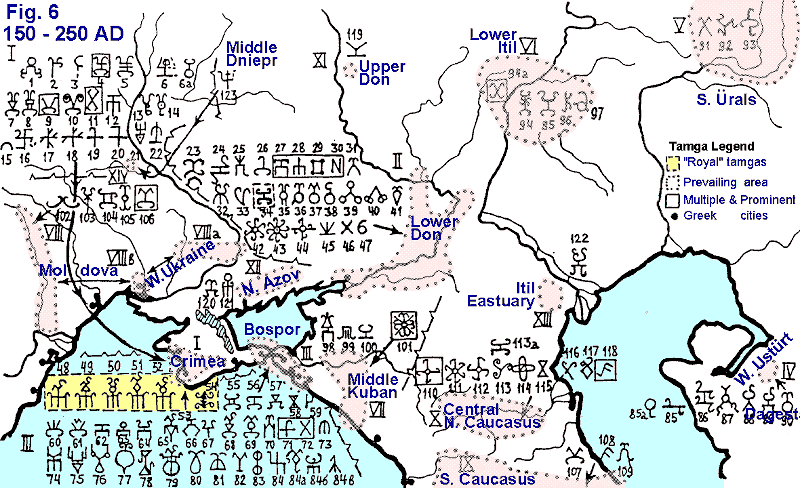
Among the tamgas of the Sarmatia are further found few tamgas, identical with the royal Horesmian tamgas on the coins (they are located in the eastern areas of the Sarmato-Alanian world closer to Horesm, but undoubtedly belong to the Sarmato-Alans: fig. 6/89, 92; 26a, on the left; compare: fig. 28/46, 29/86 - the last tamga belongs to the king, who ruled a little bit later).
| N.Pontic | |||
| Fig. 6/89 | Fig. 6/92 | Fig. 6/26a | |
|
|
|
|
|
| Horesmian coins | |||
| Fig. 28/46 | Fig. 29/86 | ||
|
|
|
||
The Sarmatian tamgas of the 2nd-3rd centuries and the later Central Asian tamgas of the 4th-8th centuries (period 3) also exist exact concurrences. But they (in contrast with the exception noted above: fig. 29/86) mostly belong to an absolutely different area: Chach (former center of Kangar, chinese "Kangüy"), and partly to the Sogd.
Fig. 29. Tamgas of the Basins of Cheyhun/Amu-Darya and Seyhun/Syr-Darya (4th-8th cc. AD)
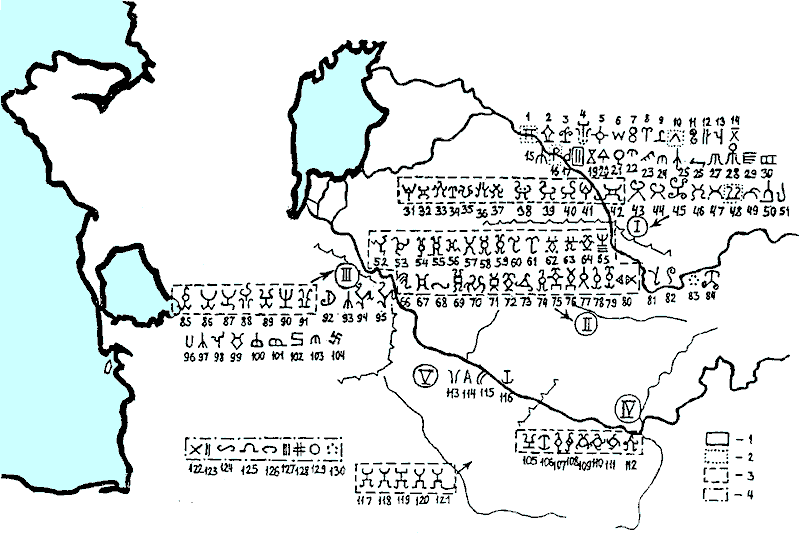
88
For the latest, mid 3rd - end of the 4th century tamgas of Sarmatia are known only two ancient, early and specifically Horesmian analogues (fig. 7/5, 26; compare: fig. 27/28, 122).
| N.Pontic | |
| Fig.7/26 | Fig. 7/5 |
|
|
|
| Horesmian coins | |
| Fig. 27/28 | Fig. 27/122 |
|
|
|
To summarize, the Sarmato-Alanian nobility during the whole period of the active usage of tamgas (from the beginning of our era to the mid 3rd century AD) is characteristic the use of the tamgas also known to be used by the kings of Horesm.
6.4. Clans Sarmatia and Bactria.
The tamgas specific to Bactria of the period 2
(fig. 28), not too frequently meet in Sarmatia.
However, the majority Bactrianian samples was represented on bricks
fortifikatsionnyh constructions and obviously concerned to ordinary clans (see
above). For a boundary one exact Kuban analogue (fig. 4/1 is AD known and;
compare: fig. 28/77), for mid 1st - mid 2nd century - on one tamga in
various areas (fig. 5/12, 18, 48, 79; compare: fig. 28/72, 84, 97, 104).
Tamga No 6 from Belbek IV necropolis in Crimea it is identical only to one of two variants of a tamga Kushan (i.e. Ku-Sün - Translator's Note) king Vasudevy I (164/184-200/220) on coins (fig. 28/104). For late-Sarmat time such analogies are at the most eastern grouping of the Alans which have left late tamga on Bajte (a plateau Ustyurt). A tamga on the type represented on fig. 6/85à (compare: fig. 28/107), is known only on gemme king Kanishki I (Harle, 1985, fig. 2) (section 5 is see higher). Other type on Bospore (fig. 6/53; compare: fig. 28/170) was small "additional" is familiar on coins of king Savromata II. The closest communications{connections} between two regions were showed when in 1-st half 2nd century AD in Southern Priuralje the culture" was made out "late-Sarmatianaja on the basis of the tribes probably coached from suburbs Kushan (i.e. Ku-Sün - Translator's Note) an of Bactria (Moshkov, 1994, 22). The popular opinion on earlier close communications{connections} of the 1st-2nd centuries, unfortunately, has no under itself the real bases (Yatsenko, 2000à).
6.5. Clans of Sarmatia and Kangar (Ch. Kangüy) (Chach).
The western surburbs of the largest "nomadic
kingdom" Western Turkestan - Kangüy it is accepted
Today to consider the native land of a powerful horde of the Don Alans of
boundary of the 1st-2nd centuries AD, that proves to be true both messages "Houhanshu",
and other materials (see, for example, the last of the report: Tsutsiev, 1999,
17-18; Gabuev, 1999, 85-118).
Besides under data "Vej ljue" (Vejshi. SH.ba), prior to the beginning
of the 3rd century AD. Kangar (Ch. Kangüy)u also Sarmato-Alans Southern Priuralja (country Jan), and
nomads taking place to the West and the country Lju Datsin bordering on Rome /
(Sarmato-Alans of Volgo-Don) (Yatsenko, 1997, 159 for a long time rendered
tribute; Treister/Yatsenko, 1998, 73-74). Under such circumstances certain
political communications{connections} of aristocracy Kangüy and separate
Sarmato-Alanian tribes are simply inevitable (however they were unequal as Alans
since a boundary AD down to the beginning of the 3rd century appear in sources as danniki Kangüy). We
shall look, as it was reflected in tamgasvom a material.
Unfortunately, to compare materials of both territories extremely difficult as
in Kangüy it is not dug out yet any rich pogre-
89
benija (in them the most interesting finds individual and well dated tamgas in
Sarmatia concentrate). Nevertheless full concurrence of some the rare types
tamgas
is indicative. For I-II it is a tamga from Right-bank Ukraine (fig. 5/101
centuries; compare: fig. 28/121).
For P-SH centuries at Sarmato-Alans we have exact analogies on later
Kangar (Ch. Kangüy)ian/chachian coins IH-VIII of centuries (i.e. at once as soon as in
region their stamping began). Available later individual chach concurrences
with "late-Sarmatianimi" in this case should not smushchatdak as
Kangar (Ch. Kangüy)sko-chach noble clans could start to use such tamgas how they
became ruling. It concerns to a specific tamga on a clan, "related Inensimeju
Bosporskomu" (rulers of. Farankat), and to one it barefooted - porskomu
(fig. 5/56; 6/55; compare: fig. 29/32). In a similar way coincide with
chachskimi and other tamgas I of century BC- I2nd century AD from different
areas Sarmatia. Among "Sarmatian" conformity there are also the tamgas on the
elementary forms distributed in the Persiaian world (fig. 4/1 and, 15; 5/15;
6/115; Drachuk, 1975, tab. 111/124; IV/211; V/422; Vll/447; IX/604), but this
last fact in itself maloinformativen.
6.6. Clans Sarmatia and Persia. The attention a number{line} of unique analogies
for the Persiaian world in lower-donian tamgas first of all draws of mid 1st - mid
3rd century to tamgas on aristocracy of Persia. The tamga on one of parfjanian
rulers is documented in two monuments 2nd-3rd centuries - on groats of a horse with stely from a burial
ground in Kozyrke (Solomonik, 1959, No
36) and on oselke from a female tomb in Ivlevke on the Lower Don (Skripkin,
1978, fig. 1/8). Tamga Vologeza IV (147-191) (Sellwood, 1971, 179, tipe 84/131)
and identical to it{her} of last from Arshakidov-Artabana IV (216-225) (a stage
of his{its} defeat from Artashira I on a relief in Firuza-bade: Ghirshman, 1962,
fig. 166; Vanden Berge/Schippmann, 1985) it is represented and on gold broshi
from kurgan 48 1-st half 2nd century AD at Kazan ("the Gold cemetery" in Kuban area) (Guschin /
Zaset, 1994, 37; tab. 14, No 142). The tamga from Nisy
(Tolstov, 1947, tab. 1) will occupy the center of one of "encyclopedias" in
Tanaise (fig. 22/6, 4).
The type Crimean tamga I-II centuries (fig. 5/14) was a basis for a two-member
tamga on one of influential rannesasanidian magicians (Gyselen, 1995, fig. 2 A,
b) (fig. 33/à, the first on the middle to a number{line}). Tamga other
influential magician (in the same place) it is identical only to a sample 2-nd
half of the 1st century AD from vicinities Olbia (fig. 5/100). A tamga on the boiler
from village Elanan (mid 2nd - mid 3rd century) (fig. 6/24), more
precisely, his{its} mirror reflection, is known on sasanidan gemme VB. AD,
where the Kushan-check, son Hosrov-kerdira, adurbed (the keeper of fire)" - one
of high-ranking officials ãîñóäàðñòâà11 is represented "Kerdir-Varahran. The tamga
identical zapadnoukrainan tamgase (fig. 5/82), is represented on popo-later
11 Serdolikovaja gemma from collections Jonatan Rosen (New York). The material
is kindly given to A.B.Nikitinym in April, 1999.
90
Not the nearest spodvizhnika Artashira I in a stage of a duel of 226 with
parfjanskim the governor on the mentioned relief in Firuzabade, on coins SHapura
I (fig. 33/ñ, 8) and on a headdress of one aristocrat at court yard SHapura I on
a relief in Naksh-i Radzhabe (Naqsh-i Rajab) (Iranische Felsreliefs, I, 1989,
fig. 2). Before us of the certificate of any communications{connections} of the
Persian nobility with Alanian, dated, probably, the beginning sasanidan
dynasties. Sign V of century AD on bars from Ktesifona (Janichen, 1956, Taf. 25)
is identical only to a sample on lower-donskom the boiler of boundary 2nd-3rd
centuries (fig. 6/25).
6.7. Clans of Sarmatia and Mongolia, Southern Siberia.
Communication{connection}
Sarmatii and these two regions not always was only indirect. Informants 1-st half
2nd century AD such authors as Dionisy Perieget and Ptolemej, locate in Europe
small ethnic groups of unnov/Hons at a mouth of Itil and in a lower reaches of
Dnepr. There are no bases to mix them with later gunns IV-VBB. (Zaset,
1994, 136-138; Yatsenko, 1998â, note 13). With I century AD in Sarmatia
there is a series of imitations objects Mongolian hunnu, less often - their
original products (Yatsenko, 1992à).
Unfortunately, today it is difficult to tell, which tamgas on petroglifah
Mongolia can be connected with historical hunnu, and what - from them
Persiaojazychnymi and other predecessors and dannikami.
On a boundary AD analogies to the Mongolian tamgas (which, however, are known and
in other areas) are individual and met on kazans (fig. 4/3, 8). In I-II
centuries in the well-known congestion petroglifov on r. The TSagan-goal in
Southwest Mongolia (where a unique series of prototypes bosporian royal and
aristocratic "triden-owls" 2nd-3rd centuries is found also) is met a
tamga on
the future aors (?) king Inismei (Vajnberg/Novgorodova, 1976, fig. 5, á)
(fig. 34/à, 1; 35/ñ, 54; sr.. Fig. 5/86).
Fig. 34. Collections of tamgas from Mongolia (a, c), Altay (b), W.Turkestan (d-f)
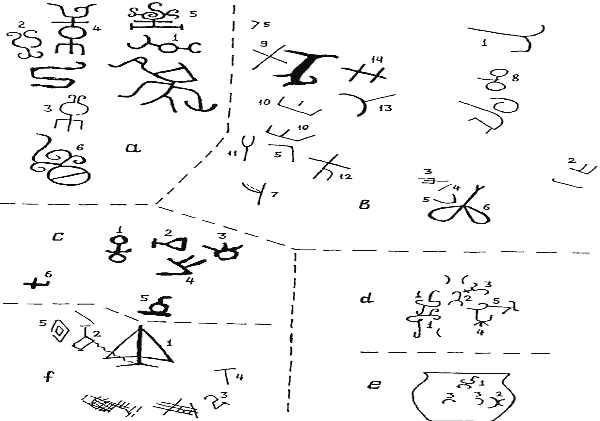
Here it is found exact analogies
to the Kuban tamgas (fig. 5/55) and most relatives - complex{difficult}
verhnedonskim (fig. 5/120). Close analogies are known exact and most and in a
number of other items{points} of Mongolia (fig. 5/12, 68-69, 107, 114). Among
them - a series of the tamgas known and in an interval between two regions - in
the Western Turkestan; they are represented in Sarmatia as in And! Centuries (see
fig. 5/8, 19, 50, 60, 62, 81), and in the 2nd-III centuries (fig. 6/22, 58).
In Anhakovskom uluse Khakassias in the autumn of 2000. By A.G.Akulovym in a
fencing Big Anhakov kurgan on one of vertical plates of a ritual fencing
of Scythian time are found among other "a tamga on Headlights - zoja" (fig.
5/85), classical bospor"tridens" (fig. 5/50), and on other plate the
tamgas
identical known early tamgas to Kuban (fig. 4/1), Right-bank Ukraine and Bospora
(fig. 5/81, 113) (the photo of plates are given in February, 2000).
6.8. Clans Sarmatia and Sogd. Quite certain affinity materalnoj cultures of
nomads Sarmatia of the 1st-2nd centuries with Sogdom
91
It was repeatedly marked in the literature (see, for example: Gorbunova, 1994).
In the West of the Great belt{zone} of steppes during Roman time assume enough
the vigorous activity sogdijian merchants. So, the name of capital in the
country Jantsaj/Alanljao (an ancestral home of Alans) on Syr-Darya on - kitajski
meant "sogdij road", and later it is named "sogdijskim city"
(Zuev, 1995, 42, 46-48).
Striking concurrences of a series of tamgas on Sarmato-Alanian nobility IHH of
centuries (last period active tamgas usage) and tamgas on sogdijian coins of
various areas VI-VIN of centuries (Smirnova, 1981, tab. LXXXVIII-XCIV) (earlier
the tradition active tamgas usage in Sogde was absent) (compare above
section 6.5) pay to themselves attention, first of all. Concurrences tamgas and
symbolics on late-bosporian and sogdijian coins involved researchers and
earlier (Musakaeva, 1995, 27). An royal tamga on nahodimyh in area of Bukhara
imitations tetradrahmam Evtidema a boundary AD (Zejmal, 1978, 209, tab. Í/5)
(fig. 28/129) is identical to a tamga from a necropolis Imperial in a mouth of
Don (fig. 5/28). Other analogies are known at Sarmato-Alans in territory of
Ukraine. Tamga "relative" Inensimey Bospor it is known on coins both in
Sogde, and in Chach (fig. 6/55; compare: fig. 29/32). Two more tamgas also find
parallels in sogdian to numismatics (fig. 6/14,105; compare: fig. 29/78-79).
6.9. Clans Sarmatia and Indo-Scythian State.
Both exact analogies to royal
tamgas on indo-Scythians (Zejonisis and Gandofar) 12 are known in
Crimea, but, unfortunately, can be dated only totally HIM{IT} centuries AD. It -
the mirror which has been casually found in necropolis Belbek IV (end I
of century AD), and a tamga from "encyclopedia" on olvijskom a lion No 1 (fig.
5/13; 14, t; Drachuk, 1975, tab. XLIV, sq. 49: here two were imposed different
tamga). Proceeding from dating belbek burials, tamgas could get to Crimea soon
after wrecks of the indo-Scythian dynasty defeated in 2-nd half of the 1st
century
AD. Kushanami.
Tamga Gandofara it is identical to a tamga on coins of the last parfjan king Artabana IV (216-225) (Sellwood, 1971, 30ò, tipe 91 iii).
92